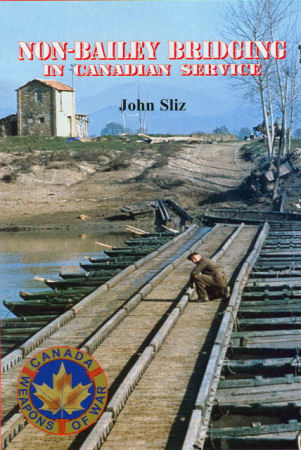
Non-Bailey Bridging in Canadian Service Book Review
By Cookie Sewell
| Date of Review | December 2010 | Title | Non-Bailey Bridging in Canadian Service |
|---|---|---|---|
| Author | John Sliz | Publisher | Service Publications |
| Published | 2010 | ISBN | 1-894581-68-4 |
| Format | 24 pages, softbound | MSRP (CDN) | $9.95 |
Review
It has long been noted that anyone carrying out warfare in Europe will run into a water obstacle roughly every 10 kilometers, and a major obstacle every 50. While some can be waded or forded, most require bridging of some sort in order to negotiate them. While the best option is always capturing extant bridges intact, that is not always possible.
As a result, bridging units have been part of armies since the time of the Persians in the 5th Century BC. But by the time of the Second World War, most armies had prefabricated bridges and engineer bridging units as part of their makeup as a matter of course.
Having previously examined engineer boats in this series, author John Sliz now turns his attention to the various types of bridging used other than the famous Bailey bridge. The Canadian Army began its work in this area with a 64 foot section of Small Box Girder (SBG) bridge purchased from the UK in 1936. This was followed by folding boat equipment (FBE) and others such as Kapok Foot Bridges and Stock Span bridging. But other than “onesies and twosies” the Canadian Army essentially had no tactical bridging prior to the start of the war.
Eventually the British Army fielded a wide variety of bridges with at least nine classes from 3 to 70 tons in use by the end of the war. Many of these were also used by Canadian forces, but unfortunately all but the lightest ones were slow to erect and install and generally had to rely on securing an area before they could be put into place.
The Kapok Assault Bridge was basically a selection of duckboards and kapok floats which could be easily strung across relatively narrow rivers to provide infantry a dry crossing, but could not easily be erected under fire nor carry great weight. Still, it did serve its purpose as with Canadian troops crossing the Orne river in Italy or the Leopold Canal in Belgium.
Another light bridge was the Olafson Infantry Footbridge, which consisted of jeep transported 15 foot sections. Again, this could not be installed under fire. A double span (e.g. two parallel tracks) would support a jeep in crossing however.
The Large Girder Bridge was designed to be a semi-permanent bridge as it was heavy, bulky, and not quickly emplaced. Able to provide Class 24 crossings (e.g. support for vehicles of up to 24 short tons weight). While faster to install than the WWI Ingals Bridge, it was replaced by the simpler and more flexible Bailey Bridge design.
The SBG served well, with the best known one to modelers probably being the twin end unit short bridge carried by a Churchill AVRE.
Other bridges for “lines of communications” or mainline transport routes include the Callendar-Hamilton Unit Construction Bridge and Track Bridges (again this type had to have two laid parallel for vehicle crossings).
Floating bridges – called “wet bridges” by the UK – were those requiring pontoons for support. These included the Mark V Pontoon Bridge, which if correctly installed was rated as Class 24 and could deal with tanks up to the Matilda; and FBE Mk II and Mk III sets, which were only rated as Class 12 (trucks and light armored vehicles only).
The WW I Ingals Bridge remained in service at the start of the war as there was nothing to replace it. Capable of proving Class 40 support (e.g. tank crossing) it remained in service until replaced by the Bailey Bridge. Unfortunately the Canadians produced several sets of these bridges at the beginning of the war, but when the Bailey was introduced they remained in Canada gathering dust.
Overall this book is not of great use to modelers, but it is interesting and provides sufficient information and closeups that a diorama builder could use it to get a bridge “right” for a diorama or vignette.
Thanks to Clive Law of Service Publications for the review copy.







